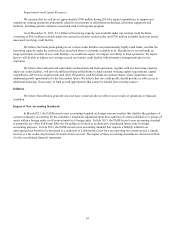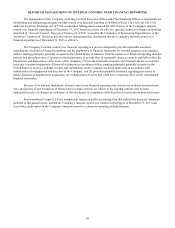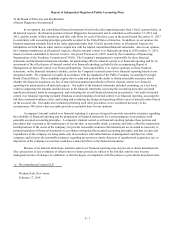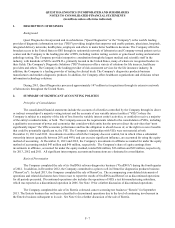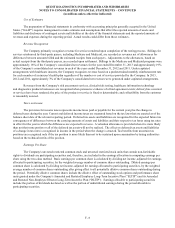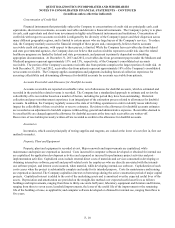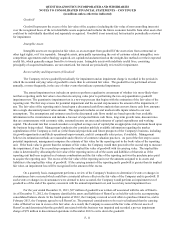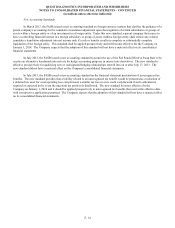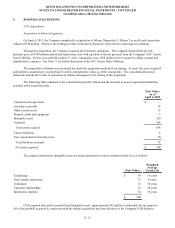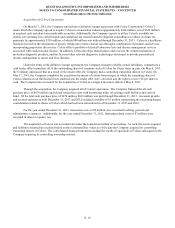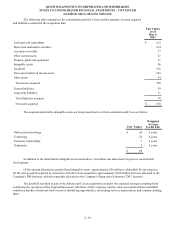Quest Diagnostics 2013 Annual Report Download - page 81
Download and view the complete annual report
Please find page 81 of the 2013 Quest Diagnostics annual report below. You can navigate through the pages in the report by either clicking on the pages listed below, or by using the keyword search tool below to find specific information within the annual report.F- 9
Stock-Based Compensation
The Company records stock-based compensation as a charge to earnings net of the estimated impact of forfeited
awards. As such, the Company recognizes stock-based compensation cost only for those stock-based awards that are estimated
to ultimately vest over their requisite service period, based on the vesting provisions of the individual grants. The cumulative
effect on current and prior periods of a change in the estimated forfeiture rate is recognized as compensation cost in earnings in
the period of the revision. The terms of the Company's performance share unit grants allow the recipients of such awards to
earn a variable number of shares based on the achievement of the performance goals specified in the awards. Stock-based
compensation expense associated with performance share units is recognized based on management's best estimates of the
achievement of the performance goals specified in such awards and the resulting number of shares that will be earned. The
cumulative effect on current and prior periods of a change in the estimated number of performance share units expected to be
earned is recognized as compensation cost in earnings in the period of the revision. The Company recognizes stock-based
compensation expense related to the Company's Amended Employee Stock Purchase Plan (“ESPP”) based on the 15% discount
at purchase. See Note 16 for a further discussion of stock-based compensation.
Fair Value Measurements
The Company determines fair value measurements used in its consolidated financial statements based upon the exit
price that would be received to sell an asset or paid to transfer a liability in an orderly transaction between market participants
exclusive of any transaction costs, as determined by either the principal market or the most advantageous market.
Inputs used in the valuation techniques to derive fair values are classified based on a three-level hierarchy. The basis
for fair value measurements for each level within the hierarchy is described below with Level 1 having the highest priority and
Level 3 having the lowest.
Level 1: Quoted prices in active markets for identical assets or liabilities.
Level 2: Quoted prices for similar assets or liabilities in active markets; quoted prices for identical or similar
instruments in markets that are not active; and model-derived valuations in which all significant inputs are
observable in active markets.
Level 3: Valuations derived from valuation techniques in which one or more significant inputs are unobservable.
Foreign Currency
The Company predominately uses the U.S. dollar as its functional currency. The functional currency of the Company's
foreign subsidiaries is the applicable local currency. Assets and liabilities denominated in non-U.S. dollars are translated into
U.S. dollars at exchange rates as of the end of the reporting period. Income and expense items are translated at average
exchange rates prevailing during the year. The translation adjustments are recorded as a component of accumulated other
comprehensive (loss) income within stockholders' equity. Gains and losses from foreign currency transactions are included
within other operating expense (income), net in the consolidated statements of operations. Transaction gains and losses have
historically not been material. The Company had previously been exposed to market risk for changes in foreign exchange rates
primarily under certain intercompany receivables and payables. The Company historically used foreign exchange forward
contracts to mitigate the exposure of the eventual net cash inflows or outflows resulting from these intercompany transactions.
As a result of the HemoCue disposition, this foreign currency risk has largely been eliminated. The Company's remaining
foreign exchange exposure is not material to the Company's consolidated financial condition. The Company does not hedge its
net investment in non-U.S. subsidiaries because it views those investments as long term in nature.
Cash and Cash Equivalents
Cash and cash equivalents include all highly-liquid investments with original maturities, at the time acquired by the
Company, of three months or less.
QUEST DIAGNOSTICS INCORPORATED AND SUBSIDIARIES
NOTES TO CONSOLIDATED FINANCIAL STATEMENTS – CONTINUED
(in millions unless otherwise indicated)


